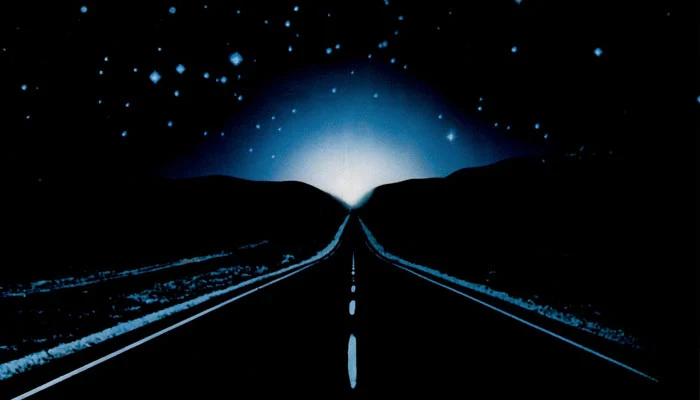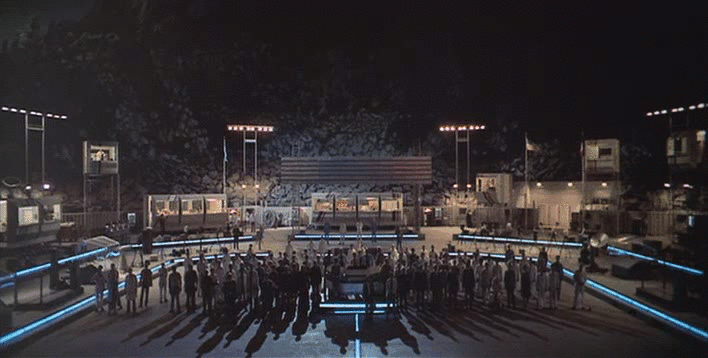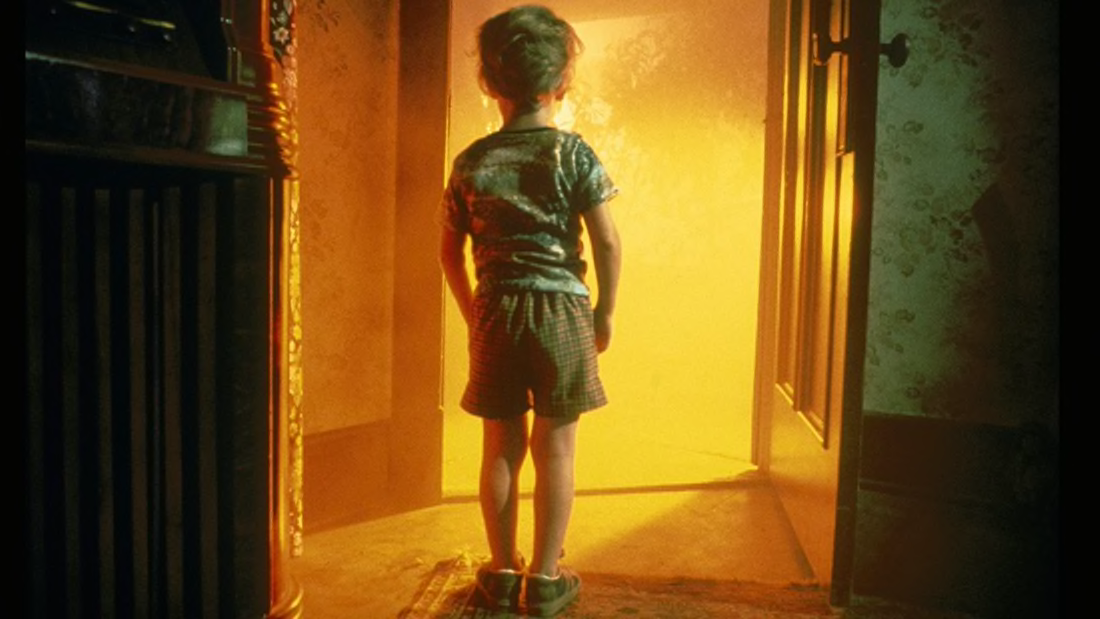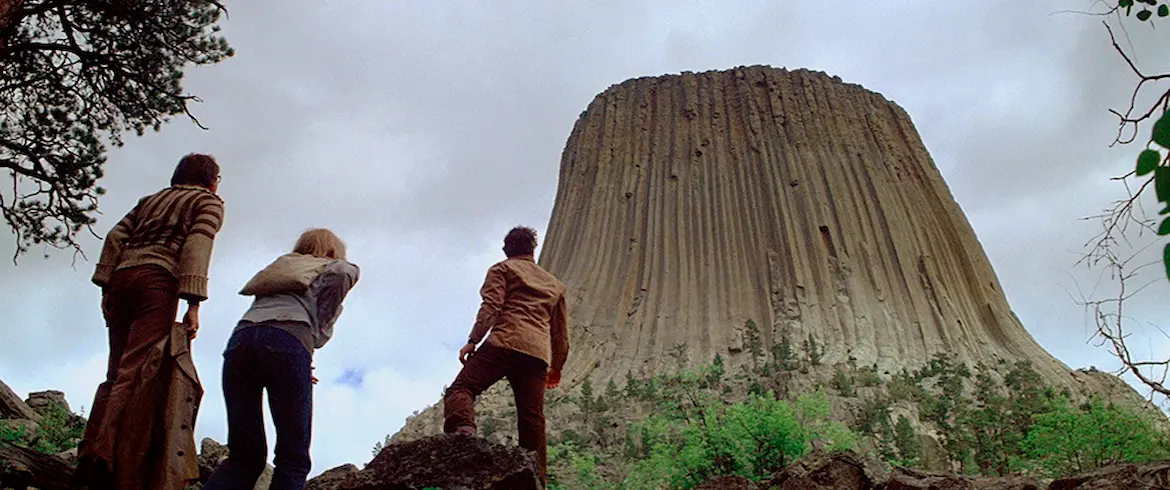
Watch “Close Encounters of the Third Kind” on AMAZON PRIME
Spielberg Truffaut and Me: An Actor’s Diary, by Bob Balaban
After the Pentagon’s release of three unclassified videos of UFO’s taken by navy pilots, it’s understandable you might be watching the skies. And if you’ve yet to see Steven Spielberg’s classic of extraterrestrial contact, Close Encounters of the Third Kind, the title of which is taken from UFO research, now might be the perfect time.
In the summer of 1976, during the first weeks of the filming Close Encounters, Francois Truffaut, who played the extraterrestrial specialist Claude Lacombe, was at work on a book about actors—tentatively titled Hurry Up and Wait. The auteur-director and founder of the French New Wave had appeared in several of his own films, as well as others, but he had trouble finding the book’s focus, and the project was never finished.
As it happens, there was a book written on that subject during that shoot, not by Truffaut, but by his co-star Bob Balaban. Spielberg Truffaut and Me: An Actor’s Diary was published in 2002, and it’s a fascinating look behind the camera. At the time of the film’s making, Balaban had already gained film credits such as Midnight Cowboy and Catch-22. Now an acclaimed producer and director, Balaban’s hunch that Close Encounters was a singular project, and one that offered a fascinating backstory, turned out to be right.

Watch “Close Encounters of the Third Kind” on AMAZON PRIME
Balaban recounts the process of the film’s production, from his own casting as David Laughlin, the cartographer whose conversant French finds him suddenly recruited as Lacombe’s interpreter, to location shoots in Wyoming, Alabama, the Mojave Desert, and India. Balaban faithfully records the daily reality —the boredom, the creativity, and on-the-spot inventiveness, as well as the bonds that were forged in what became a tight-knit community far from home (for more on that sense of film family, see Truffaut’s classic film about films, Day for Night).
Balaban reveals much about an actor’s daily life on set.
“Acting in a movie,” he writes, “especially one with the scope of Close Encounters, can be a difficult experience. You spend very little of your time doing what you are actually hired to do—act.”
It’s fascinating too, to read about the complexities of making a film of this magnitude. Close Encounters was made pre-CGI, and each special effect had to be constructed in analog. This included the alien ships created by production designer Bob Alves and his team. The details include the now-iconic clouds generated by the mothership (a mix of paint roiling in fresh and saltwater), as well as the otherworldly atmospheric effects caused by the ship’s innumerable lights—a haziness created by shooting the model-sized ships through veils of smoke in a black velvet room.

Watch “Close Encounters of the Third Kind” on AMAZON PRIME
Spielberg’s previous film, Jaws, brought the director acclaim, blockbuster status, studio backing, and the exorbitant budget for CE3K. While that first film’s central prop was the famous (and famously malfunctioning) great white shark, Close Encounters had a sound stage of unprecedented size. The famous airstrip behind Devil’s Tower, site of the mothership’s landing and subsequent contact (of the fourth kind) with humans on earth, was constructed in an immense abandoned dirigible hanger on a disused airbase outside Mobile, Alabama. As Balaban notes on first seeing the set:
“…spread out below me is an astonishing sight: a long, concrete landing field stretches out for what looks like miles. It is surrounded by piles of rocks which look exactly like the rocks at the base of Devil’s Tower. It’s as if we never left Wyoming.”
As Spielberg proudly shows off the upper reaches of the immense set to his principal cast, Balaban writes, “The stairs are really shaking now, and I hold on to the wooden support slats with both hands. Nobody seems to mind. Truffaut is fascinated by all of this. I try to translate [Truffaut’s French] for Steven, but my translation gets vaguer as my vertigo increases.”

Watch “Close Encounters of the Third Kind” on AMAZON PRIME
Balaban also looks at the more ordinary detail of what it’s like to work on location. This actor’s diary shows us Truffaut and Balaban on their first night meeting in Gillette, Wyoming, walking out of a local restaurant because a country-western band is blaring, and Truffaut can’t stand loud music during dinner. We see the extras who are fired due to excessive beer consumption, and the protest they mount at learning they have to cut their hair in order to look like government aerospace workers. There is Balaban and Truffaut, grabbing lunch in an A-frame cafe at the base of Devil’s Tower, which for the film sports a sign that reads “Decontamination Camp.” Balaban also reveals his regret at the ordinary trousers and jacket he brought for his character of Laughlin after seeing Truffaut’s superbly tailored Parisian clothes.
We learn too that Balaban was not completely confident in his ability to speak French, even with the carefully prepared lines he’d brought to the audition. Truffaut too was self-conscious, and good-humored, about his English, and this mutual challenge around language forged a bond between the two, one that continued until Truffaut’s death in 1984.

Watch “Close Encounters of the Third Kind” on AMAZON PRIME
Balaban’s hunch that Spielberg’s extraordinary film, with its groundbreaking visuals and singular cast, warranted daily journaling, was prescient. The film has become a classic of its time, and notable as the only American film in which Truffaut appeared, despite the director’s lifelong devotion to and exhaustive knowledge of American cinema.
Spielberg, Truffaut and Me is a memoir filled with fascinating detail of what it’s like to make your living as an actor, and live a life that centers on making films.
—Lauren Alwan
Glow, by Ned Beauman
Raf is 22 years old, and living in London, at least for a while longer. He just broke up with his girlfriend and feels like he has to get away, has to start over somewhere new. Problem is, he doesn’t have a lot of motivation to do much of anything. Due to a sleep disorder, he’s unable to hold a conventional job but, because he’s 22 years old and living in London, he’s not that much into convention anyway. So for a little cash he walks Rose, a loving Staffordshire terrier who otherwise spends her time guarding the antenna for a pirate radio station owned by Raf’s friend, Theo, and at nights he attends guerrilla raves (often DJ’ed by his roommate, Isaac), does drugs, and generally hangs on.
But one night, he meets a beautiful girl at a rave in a crowded laundromat, and learns about a new drug hitting the streets called glow. Then Theo disappears, and once Raf starts trying to find him, things get weird. Soon he’s embroiled in a corporate conspiracy reaching all the way to Burma, which, consequently, is where the girl of his dreams is from, as is the guys who seem to have taken over the radio station, and the guys with the glow…. And that doesn’t even start to explain the foxes that have turned up all over London….
And then things start to really get weird.
Glow is a glittering, snappy thriller that is full of low key dichotomies that enhance the story rather than detracting from it. Raf is a smart kid with a sharp mind, but he’s also a bit of a slacker, comfortable with what he has – and what he doesn’t. When he’s trying to find out what happened to Theo, he doesn’t turn into a super sleuth, but he does use the knowledge he has – an awareness of drug culture and the internet savvy to learn more – to turn up clues that all the corporate know-how of the multi-national at the heart of the turmoil can’t even begin to fathom. He stumbles onto their schemes and doesn’t know enough to be terrified, gaining him access that long term schemers marvel at. Nevertheless his naive moxie mixed with his urban street smarts feel genuine, even while the situation at hand spirals deeper and deeper into the fantastic.
Don’t look for formula here. No flinty eyed detectives. No evil CEOs. No minions… even the bull terrier is an archetype of the pups you see at the dog park rather than the curs at the junk yard. And that’s part of what makes Glow so good – it feels plausible, and yet way out there. You’ll learn about monomethylhydrazine and diurnal cycles, how to kill hogsnakes in the jungle, and even Carl Linnaeus’ Horologium Florae, and it will all feel cool. Even if you’re not in your mid-20s anymore.
—Sharon Browning
Other Titles by Ned Beauman
Other LitStack Resources
Be sure and check out other LitStack Recs and LitStack Reviews to find what you should read, and also check out other articles by Lauren Alwan and Sharon Browning.
As a Bookshop and Amazon affiliate, LitStack may earn a commission at no cost to you when you purchase products through our affiliate links.




